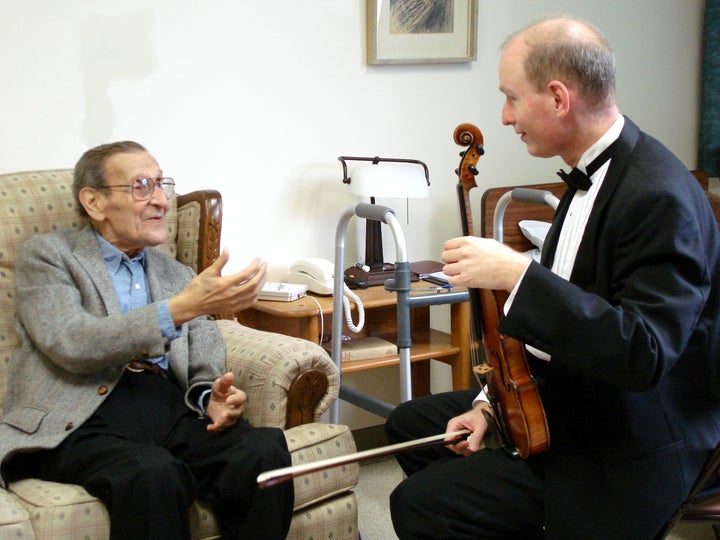
A Special Concert for Ed
This article focuses on special activities to engage and entertain people who have Alzheimer’s or another dementia. For a comprehensive list of activities for seniors without the disease, please refer to Vive Health’s excellent article, “99 Activities for Elderly and Seniors – Ultimate List.” It contains 99 suggested activities in the following five categories: 1. Get Out and About, 2. Health and Fitness, 3. Find a hobby, 4. Education, and 5. Additional Income. There is a short blurb about each activity.
Making a connection is essential for the wellbeing of people living with Alzheimer’s. There are four special activities that can typically reach and engage people at any point in the disease’s progression, even those in the later stages who may no longer talk or smile, let alone recognize love ones.
It goes without saying that some people with Alzheimer’s cannot be reached by any means and cannot enjoy any type of activities, but try experimenting with the ideas mentioned here. Caregivers are sometimes amazed to find that their loved ones can suddenly function at a higher level when involved in certain types of activities.
When choosing activities it’s important to select things loved ones enjoy and are capable of doing at their state of the disease. If you try to engage with people who have Alzheimer’s the way you did before they developed the disease, you may end up disappointed, disheartened, and possibly even depressed.
Engaging with your loved one at his or her current developmental level, however, can lead to unexpected pleasure – even joy - for both of you!
Some special activities are virtually guaranteed to reach persons at all stages of the disease. The four most common are 1) Being visited by a child, 2) Being visited by a pet, 3) Listening to or performing music and 4) Observing or creating artwork. Let’s look at each individually:
1. Being Visited by a Child
It’s a well-known fact that children can reach people with dementia at a deep emotional level that adults often cannot. Blank stares may remain blank when an adult enters the room, but when a child comes in, those stares may turn to smiles, even for people in the latest stage of the disease.
Children can play with patients just as adults can. If you need some specific ideas check out the Alzheimer’s Association website, which has a list of 101 things a child can do with someone who has Alzheimer’s.
Arranging for a beloved grandchild or other young child to visit may be just what the doctor ordered. When doing so, of course, be sure the child wants to visit and feels comfortable doing so.
2. Being Visited by a Pet
Much like children, animals can often touch people with Alzheimer’s more deeply than people can. Ed, my life partner who developed Alzheimer’s, typically ignored me completely whenever I took my little Shih Tzu, Peter, to visit him. He focused all of his attention on the dog.
I’m reminded of a mid-stage Alzheimer’s patient at the facility where Ed lived who always had a blank expression on her face and never answered my greeting. I never heard her talk to anyone else either. But her eyes always lit up when I took Peter with me. Then one day when I arrived without him she spoke to me for the first time ever, asking “Where’s the dog?”
There was another incident with a late-stage lady with Alzheimer’s whose face Peter licked when I held him up for her to see. I told her Peter didn’t usually “kiss” people he didn’t know, and she immediately answered, “Dogs are very selective.” Her son told me that was the first lucid remark she’d made for months.
3. Listening to or Performing Music
Music also has the power to reach loved ones with Alzheimer’s on a profound level. It may have positive effects on their health and social functioning. After listening to music, some are clearly calmer, in a better mood and more outgoing than before, which improves the quality of life for both the patient and the caregiver.
Oftentimes people with late stage Alzheimer’s can sing songs, including all of the lyrics, long after they’ve lost the ability to talk, recognize loved ones, dress themselves, or remember what happened five minutes earlier. You may even find that music is the only thing to which some late stage loved ones will respond.
4. Observing or Creating Artwork
If your loved one is able to go out, a trip to an art museum could be beneficial. Just looking at art, much like listening to music, has been shown to calm people with Alzheimer’s.
Working on art projects is also an excellent activity for people with Alzheimer’s because it uses a part of the brain that is less affected by the disease.
People living with Alzheimer’s can sometimes create striking art work that allows them to express themselves and connect with their loved ones.
You can arrange various types of art projects. Common activities include painting with water colors, coloring with crayons, making scrapbooks or molding objects with clay.
As with the other activities mentioned in this article, it’s important for you to participate in the process by sitting beside and interacting with the person while they create art.
So there you have it – children, pets, music and art. Try them out. I hope one or more of them will be rewarding in some way for you and your loved one.
Marie Marley is the award-winning author of the uplifting book, “Come Back Early Today: A Memoir of Love, Alzheimer’s and Joy,” and co-author (with Daniel C. Potts, MD, FAAN) of “Finding Joy in Alzheimer’s: New Hope for Caregivers.” Her website (ComeBackEarlyToday.com) contains a wealth of helpful information for Alzheimer’s caregivers.